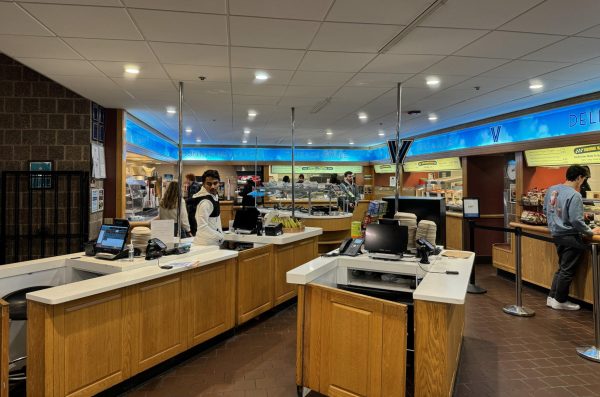Luxury Fashion on Villanova’s Campus

Courtesy of Olivia Pasquale/Villanovan Photography
During the winter season, many Villanova students sport luxury brands on campus.
March 16, 2022
Even as the cold Pennsylvania winter draws to a close, winter jackets are still a common sight on Villanova’s campus. While students choose to adorn themselves with coats from many different brands, one seems to rise above the rest: Canada Goose.
Often distinguishable by its fur/feather hoodruffs and red, white and blue arctic expedition patch on the left bicep, Canada Goose jackets have a cultural presence on this campus unlike their brand counterparts like Moncler and Moose Knuckles.
Another Canadian label with a strong grip on our student body’s wardrobe is Lululemon, whose distinctive fabrics can be seen adorning the chests and legs of everybody, from athletes to Davis Center attendees to everybody else. While the brand’s stylized “A” logo may be small, its prevalence is seemingly larger than life.
Why are these brands so popular? While both companies make very good and stylish products that many people swear by, even I can admit that a similar coat from North Face would be just as warm as my Canada Goose parka, and Gymshark shirts and shorts would perform nearly as well on the tennis court as my Lulu ones do, for a much lower price.
In truth, Canada Goose and Lululemon have built up such a cult following not only because of the quality and performance of their gear but also because of their branding: they sell ideas.
Canada Goose is all about its “Made In Canada” tagline. Its “Craftsmanship” page states that “Made in Canada isn’t just a slogan. It means that every one of our coats is sewn in the same country from which we draw our inspiration.”
It also claims that “jackets pass through the agile hands of 13 different people before they’re delivered to you,” and that “before it leaves the nest, our quality assurance team inspects every jacket by hand.” Canada Goose’s success is owed to the idea it sells: that one is buying a time-tested, handmade, quality product that will last for years.
Lululemon’s success is also dependent on its brand ethos. The page on its website titled “Our Business” states its goal as: “Helping our collective be well in every aspect of their lives – physically, mentally and socially – is at the core of how we create our products and experiences.”
The customers are called ‘guests,’ and Lulu’s products help “[realize] the potential in every one of us.” A person has a certain air about them if they wear Lululemon: they are sophisticated, healthy, astute and most importantly: successful. Lululemon “guests” are the ideal example of a modern, productive member of urban society.
While these cultures have largely contributed to the iconic status of these brands, there is more to their success. These brands are classified as “luxury” for a reason. Most Canada Goose parkas’ price tags are almost as heavy as the jackets themselves, costing upwards of $1000.
The prices of Lululemon’s goods are similarly high compared to its competition, with the iconic Metal Vent Tech short sleeve setting one back $78. We are firmly in what many people would call “why would you pay that much for that?” territory.
These brand cultures are particularly influential on this generation of young people. The fashion sphere is invaded by flex culture, which places constant pressure on people to always be draped in the hottest and hippest brands, lest their fashion sense be considered subpar.
This pressure is certainly implicitly embedded in Villanova’s campus. It is no secret that a good-sized portion of the student body comes from the upper-middle to upper class, judging by the amount of Range Rovers, Mercedes and BMWs present on move-in day. Such privilege can beget similar fashion tastes, which often encompass the two favorite Canadian labels.
Wearing these brands is certainly a symbol of privilege and can certainly rub others the wrong way. It can be seen as a way of flaunting excess wealth that is not necessarily yours.
I remember scrolling through YikYak the day before winter break and seeing many posts pointing out the alleged overvalue of the clothing on campus, with people claiming that those who wear the brands are spoiled, narcissistic brats.
The presence of Canada Goose and Lululemon, as well as luxury fashion in general, on our campus highlights an issue which lies under the surface of Villanova discourse: classism.
It is a delicate subject that is rarely talked about in a serious capacity. The presentation of and reaction to luxury fashion thrusts the issue into the eyes and ears of most of the student body.
Overall, we need to do a better job of acknowledging the lack of diversity of socio-economic backgrounds present in our community, and the role that this wealth plays in student experiences on our campus.








Martine • Oct 16, 2022 at 11:14 pm
NorthFace doesnt even come close to being as warm as Canada Goose coat. In fact, while North Face is stylish and cute, that is about all that can be said for it. Its no warmer then any down coat( which is really the only warm coats that exist). I live in Minnesota, where the campus is large and cold, and I know. Any coat that was as warm as CG would also be equally expensive. Lululemon isnt really that great for the price, but they are really good with choosing fun colors.
And I wouldn’t even try to “call out” classicism. Because woeness is a part of litism. So ironically the more you “call out” certain brands the more of an elitist pap you become. Only certain classes “call out” nonsense. Let people wear what they like and enjoy it. The reason people dont like the social group you refer to is precisely BECAUSE they meddle incessantly as if someone elected all of you to decide what is best for our world. No one asked for your help.